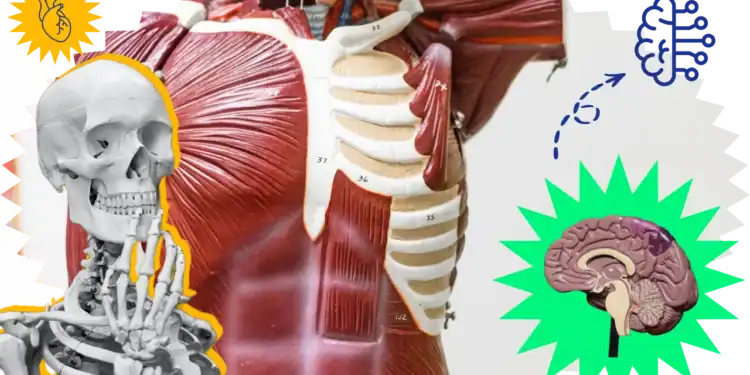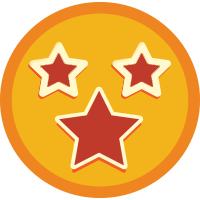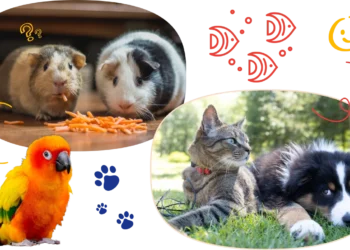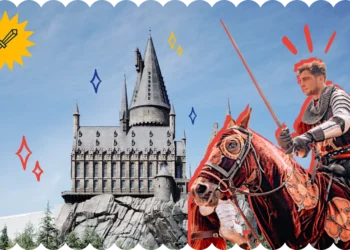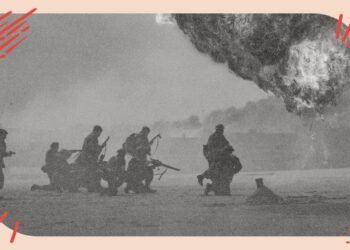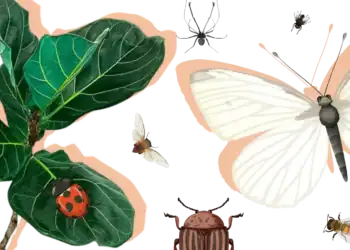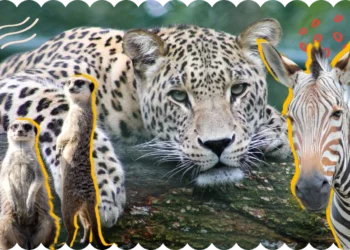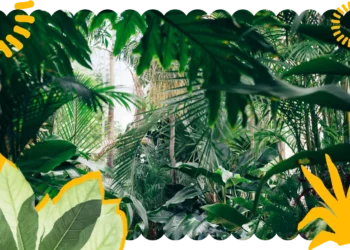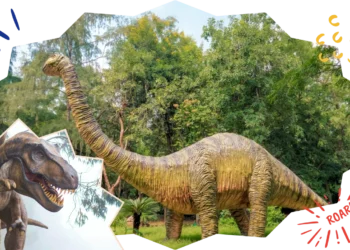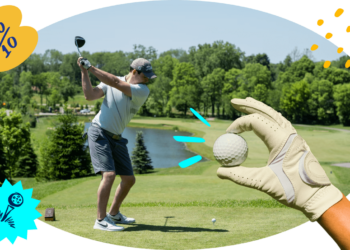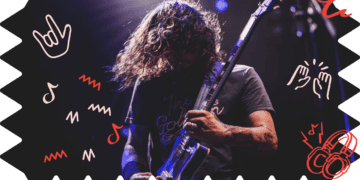We all have human bodies, but how much do we actually know about those bodies? Scientists learn more every day about the meat sacks we live in. Quick: How many bones are in an adult human’s body? Which bones are the biggest and which are the smallest? How many ribs do humans have? Which joint is the largest? What’s your body’s largest organ? What determines your eye and hair color?
These are just some of the questions about anatomy that are ready to stump you.
If you didn’t go into the medical field, you probably haven’t taken an anatomy class since high school. Do you remember enough to ace this anatomy quiz? If you’re the type of person who knows that your brain accounts for 20% of calories burned, or that the fallopian tubes and ovaries aren’t actually attached, or that there are no muscles in your fingers, then these anatomy trivia questions and answers are for you!
Looking for more trivia? Check out our physics, biology, and chemistry trivia. And you know what, top it all off with some general science trivia questions to test your knowledge.
What was the first effective antibiotic used in medicine?
Ampacillin
Penicillin
Corcillin
Mycocillin
A pedicure is performed on what part of the body?
Eyes
Bikini line
Feet
Hands
Where in the body would you find the jejunum?
Intestines
Wrist
Ear
Brain
What disease is commonly called lockjaw?
Anthrax
Tetanus
Chicken pox
Cholera
Which of these is the abbreviation for haemoglobin?
Hg
Hm
Hb
Hn
Over which organ of the body do the adrenal glands lie?
Pancreas
Tonsils
Kidneys
Lungs
What does the ‘A’ in DNA stand for?
Active
Acid
Animation
Assistance
What on the human body, and especially on the face, are lentigines?
Moles
Freckles
Blackheads
Warts
After how long in the womb does a human baby acquire fingerprints?
32 weeks
13 weeks
6 weeks
26 weeks
What is the best way to test a new drug’s effectiveness?
Play group
Swim group
Control group
Subject group
The malleus, incus and stapes are tiny bones found in which part of the human body?
Pelvis
Knee
Wrist
Inner Ear
Which of these stages of human development lasts longest?
Adolescence
Gestation
Adulthood
Childhood
What acid is found in the stomach?
Euphoric
Acetic
Nitric
Hydrochloric
In the eye, what’s the name of the hole through which light enters?
Retina
Pupil
Cornea
Iris
Where is the canal of Schlemm?
The eye
The ear
The heart
The foot
Encephalitis is the inflammation of which part of the body?
The brain
The liver
The heart
The testicle
How many gaps in its skull does a newborn baby have?
Seven
Ten
None
Two
What does the immune system use to recognize bacteria and viruses?
Atamans
Antidotes
Antibodies
Artifices
Where would you find the metatarsals?
Chest
Toes
Finger
Ears
Gingivitis affects which part of the body?
Gums
Cheeks
Teeth
Eyes
What is the name of the holes in the nose?
Cavities
Septums
Sinuses
Nostrils
In which part of the human skeleton will you find the Sacrum, Ilium and Pubis?
Head
Feet
Chest
Pelvis
Which of the following is not a way in which the body gains water?
Eating
Drinking
Swimming
Standing in the rain
Which chemical element, a powerful disinfectant, is found in the thyroid gland?
Iodine
Lutetium
Chlorine
Rutherfordium
In the human body, what is the aorta?
Artery
Nerve
Bone
Muscle
What are you suffering from if you have coryza?
Appendicitis
Tonsillitis
Dermatitis
Common cold
How many bones are there in an adult human body?
206
365
123
99
What pumps blood around your body?
Liver
Stomach
Heart
Lungs
How many pairs of ribs in the human body?
12
10
14
16
Which animal used to roam in huge herds across the American West?
Dog
Elk
Cat
American buffalo
Which is the hardest substance manufactured by the human body?
Cartilage
Bone
Nails
Tooth enamel
What name is given to those parts of the body which connect muscles to bones?
Ligaments
Arteries
Tendons
Nerves
Where in the human body is myoglobin found?
Brain
Stomach
Liver
Muscles
Which two joints are connected by the body’s longest bone?
Ankle and hip
Hip and pelvis
Pelvis and knee
Knee and ankle
Which color blood cells carry oxygen and give blood its distinctive color?
Blue
Yellow
Green
Red
How big is the moose population in Alaska?
200
120000
1000000
20000
When was the first documented record made of animals in captivity?
Ancient Egypt
Middle ages
Roman period
Ancient Greece
Which best describes the spinal cord?
Bone
Muscle
Nerve
Skin
Broken bones are usually held still while they heal with what?
A Cup
A Pot
A Jar
A Saucer
Who was awarded the Nobel Prize in Physiology or Medicine in 2010 ‘for the development of in vitro fertilization’?
Paul Müller
Maghdi Jacoub
Oliver Smithies
Robert G. Edwards
What effect does exercise usually have on metabolism?
Decrease
Increase
Start
Delay
Where in the human body do you find the protein keratin?
Hair
Saliva
Liver
Skin
Lentigines is the medical term for what facial feature?
Cleft chin
Freckles
Dimples
Cold sores
In biology, the alimentary canal is the main part of which system?
Respiratory
Digestive
Lymph
Reproductive
What can cause tonsillitis?
Malnutrition
Antibiotics
Fungus
Bacteria
Where on the body is the conjunctiva?
Mouth
Ears
Nose
Eyes
Passive immunity involves receiving what?
Antibodies
Antigens
Antitoxins
Antifungal
What organ famously has very little function in humans?
Appendix
Gall bladder
Liver
Kidney
What is the substance that the body over-produces in an allergic reaction to pollen?
Mistamine
Ristamine
Histamine
Thistamine
Where in the body is the stirrup?
Knee
Ankle
Inner Ear
Nose
Which form of scanning was introduced in 1971?
DOG scanning
FISH scanning
CAT scanning
ANT scanning
What is another word meaning masticating?
Singing
Chewing
Dancing
Walking
Which of these is not a natural color for human hair?
White
Brown
Black
Green
Which of these human cell types has very long wire-like arms?
Fat
Bone
Muscle
Nerve
The lack of which gas is the general cause of yawning?
Helium
Oxygen
Nitrogen
Carbon dioxide
Which of these is a benefit of sunbathing?
Vitamin D production
Vitamin A production
Sun burn
Skin cancer
If you are suffering from glossitis, which part of your body is inflamed?
Tongue
Adenoids
Ear
Throat
Which part of the body holds bile?
Brain
Appendix
Gallbladder
Heart
In human biology, what is the more common name for the calcaneus?
Knuckle
Spare rib
Ankle bone
Heel bone
What sort of injury would result in being unable to walk?
Rib cage
Wrist
Finger
Spine
Which of these fats are bad for your health?
Z fats
Cis fats
Trans fats
S fats
What is the pH of the stomach?
10 to 12
12 to 14
-1 to 1
1 to 3
Which of the following is an organ?
Muscle
Lung
Blood
Phloem
Why is DCAACD easier to remember than CDDACA?
Repeating letters
Contain the same letters
Both have six letters
There is a pattern
For their discoveries connected to ‘therapy’ to combat a disorder affecting which organ of the body did Whipple, Minot and Murphy share a 1934 Medicine Prize awarded by the Nobel Institute?
Kidney
Heart
Lung
Liver
Moisturising helps to avoid what?
Wet skin
Soft skin
Dirty skin
Dry skin
A human’s left lung contains how many lobes?
3
4
2
1
Where in the body is the deltoid muscle?
Back
Stomach
Shoulder
Bottom
Which of the following is not part of the heart?
Bronchioles
Atrium
Aorta
Ventricle
Where exactly in the human body are the intercostal muscles?
Between the ribs
Between eyes
Between the fingers
Between the toes
Alcohol is an example of a what?
Hormone
Stimulant
Depressant
Fragment
Which gland produces melatonin?
Adrenal
Pituitary
Thyroid
Pineal
Where in the human body are the Islets of Langerhans?
Gall bladder
Liver
Spleen
Pancreas
How is the clavicle commonly known?
Ankle
Collar bone
Rib cage
Shinbone
What’s the name of the flap of muscle that prevents food going down the windpipe when we swallow?
Incus
Diaphragm
Pyloric sphincter
Epiglottis
Vitamin D deficiency can lead to which disease?
Crickets
Thickets
Pickets
Rickets
Which part of your body is affected by phlebitis?
Muscles
Skin
Nerves
Veins
The outside layer of skin on the human body is called the what?
Epidermis
Enterdermis
Interdermis
Midermis
The third molars in a human being are commonly known by what name?
Eye teeth
Knowledge teeth
Wisdom teeth
Canine teeth
Which part of the body produces the hormone Somatostatin?
Pituitary gland
Pancreas
Thyroid gland
Liver
Where in the human body are the lungs located?
Chest
Neck
Abdomen
Throat
Where in the body are the trapezius muscles?
Back
Groin
Thigh
Leg
Which of the following artificial systems is a model for how homeostasis works?
An incubator
A lawnmower
A camera
A microwave
In the human body, what do ligaments hold together?
Intestines
Bones
Follicles
Nerves
Where in the human body is bile stored?
Lungs
Kidneys
Pancreas
Gall bladder
Which of these is an organ in the body?
Heart
Club
Diamond
Spade
What is the normal resting heart rate for an adult?
10-20 beats per minute
100-120 beats per minute
60-80 beats per minute
20-30 beats per minute
Which bone is not in the leg?
Humerus
Radius
Ulna
Femur
What are the bones called that make up a spine?
Tibia
Femur
Vertebrae
Cranium
Which of these structures contains no bones?
Spine
Nose
Rib cage
Foot
Where in the human body would you find the hypothalmus?
Near the liver
Under the arm
Brain
In the ear
The larynx is found where in the human body?
Foot
Knee
Neck
Shoulder
Which is the only human cell type not to contain any DNA?
Skin cells
Muscle cells
Nerve cells
Red blood cells
Which of these is NOT one of the three parts of an insect’s body?
Tail
Abdomen
Thorax
Head
What is the technical name for the structure dividing the nostrils?
Sputum
Scrotum
Sacrum
Septum
Which of these is not a type of muscle?
Skeletal
Cardiac
Smooth
Brain
In human biology the smallest bone is the stirrup found in the ear. What is it similar in size to?
Grain of rice
5 pence piece
20p piece
Cornflake
What are the two kinds of blood cells?
Orange and white
White and Red
Red and pink
Green and blue
About 10 percent of the population have an accessory or extra what?
Gall bladder
Pancreas
Spleen
Bladder
What is the name of the ‘tubes’ which connect the kidneys to the bladder?
Urethra
Urine
Urea
Urinary
What is the correct name for the kneecap?
Tarsus
Malleus
Scapula
Patella
You can do better
Not bad
Great!

